Cosmeticians probably won't agree, but scientists say eyelashes have an optimal length: a third of the width of the eye.
This ratio helps keep the eyes wet, according to a study that attempts to answer the question: What are eyelashes for anyway?
"They've been hypothesized to act as sunshades, dust catchers and blink-reflex triggers," said David Hu, a mechanical engineer at the Georgia Institute of Technology in Atlanta. "But there's been no really systematic study of what their true benefits are." [The 12 Weirdest Animal Discoveries]

Hu and his colleagues went to see the lashes on animal pelts in the basement of the American Museum of Natural History in New York. They measured the eye openings and lashes from 22 mammals — ranging from the beady-eyed Amur hedgehog to the giraffe, whose eyes are about 1.5 inches (4 centimeters) across. (For comparison, the human eye opening is about three quarters of an inch, or a little less than 2 centimeters.)
The researchers discovered that lashes get longer as the eyes get bigger. On average, animals' eyelashes were a third of the width of their eye opening.
Hu and his colleagues suspected that eyelash length had something to do with channeling airflow, and they devised an experiment to find out. In the lab, the researchers made mock human eyes out of small petri dishes fitted with fake eyelashes of different lengths and a bit of water, meant to mimic the thin film of tears on the surface of the eye. The researchers tested how quickly water would dry up from the dishes in a low-speed wind tunnel. They found that the lashes of optimal length were the best for preventing evaporation.
Why eyelash extensions may be a bad idea
Eyelashes create a "speed bump" that diverts airflow away from the surface of the eye, Hu said, so having no lashes would leave the eyes vulnerable to evaporation and incoming debris that can cause infections. You might expect this speed bump to get more effective as it gets bigger, Hu said, but eyelashes that are too long can funnel airflow into the eye, causing more evaporation and drying the eyes.
Should you toss your fake eyelashes? Maybe not. But perhaps you should take your beauty cues from the camel. Camels have two rows of dense eyelashes — which probably provide extra defense against the dry, sand-laden desert air.
"The more dense you could make your eyelashes, the better it would be," Hu said.
The study, led by Guillermo Amador, a graduate student in Hu's lab, was published Tuesday in the Journal of the Royal Society Interface. (Last year, Hu's lab found another peculiar rule in the animal kingdom: most mammals take 21 seconds to pee.)
— Megan Gannon, LiveScience
This is a condensed version of a report from LiveScience. Read the full report. Follow Megan Gannon on Twitter. Follow LiveScience on Twitter, Facebook and Google+.